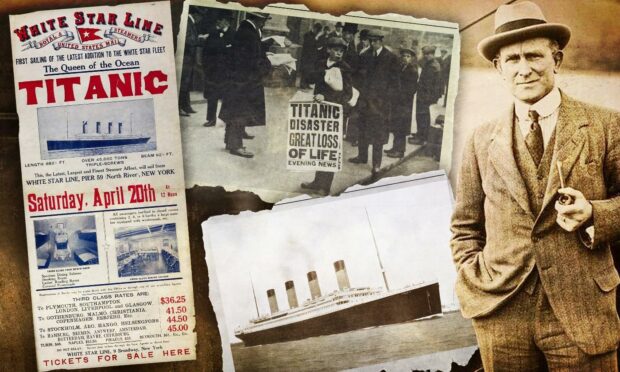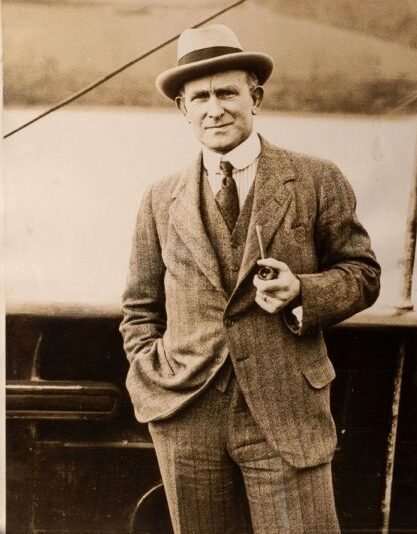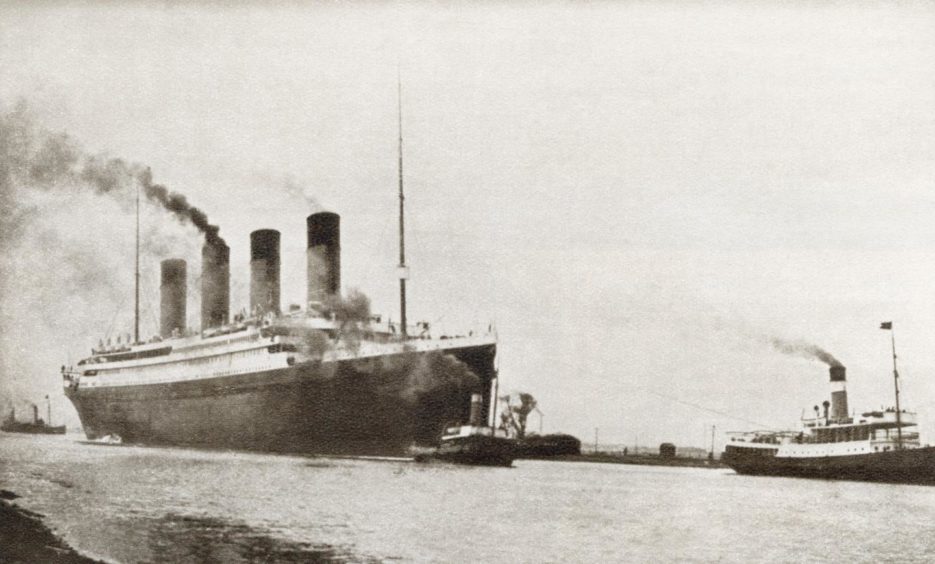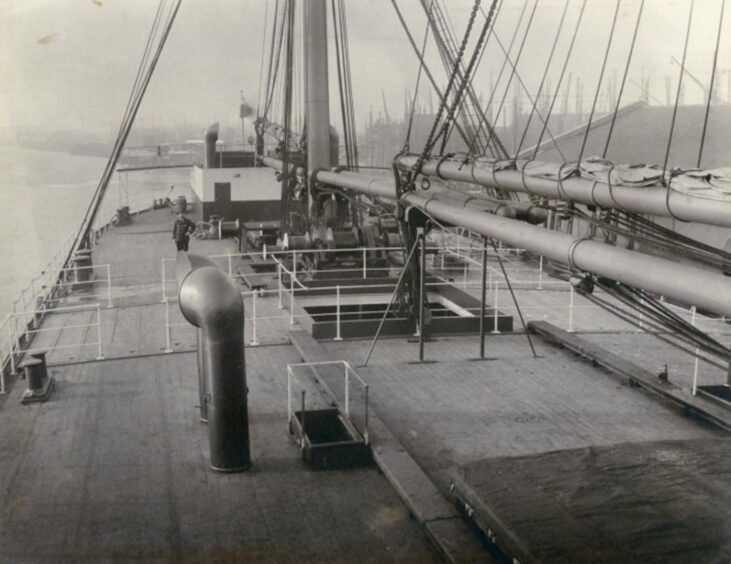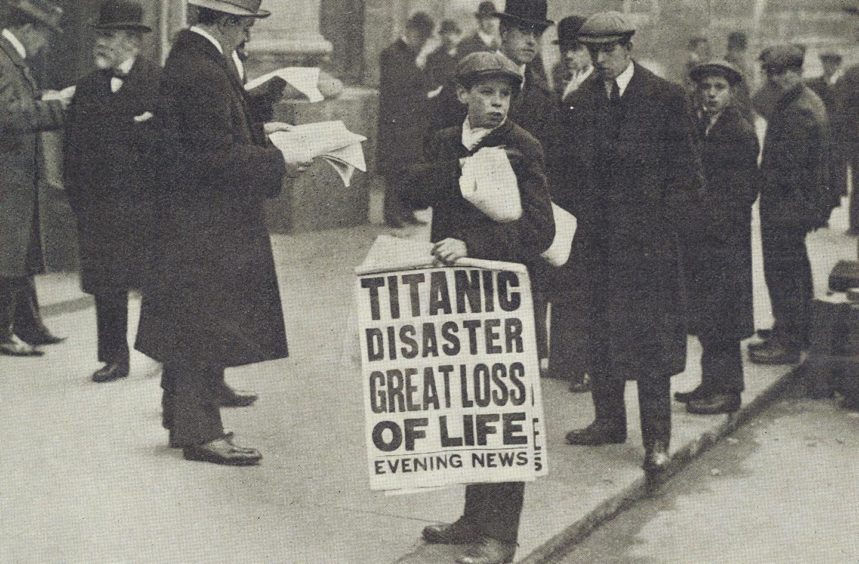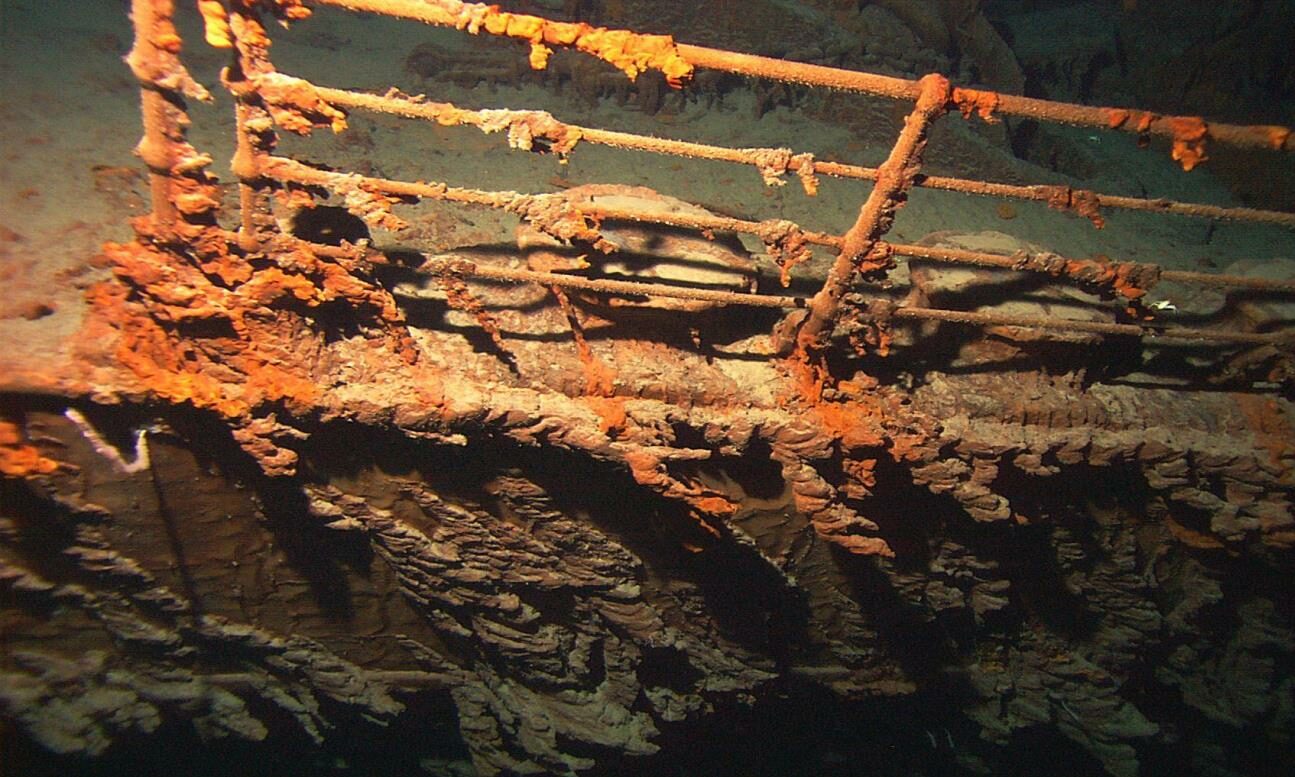The myth has stuck for more than a century but Dundee Man Lost at Sea was not the headline when news broke of the sinking of the Titanic.
However, the city has many links to the disaster including some as unimaginable as the ‘unsinkable’ ocean liner’s plunge to the icy depths on April 14/15 1912.
‘Practically unsinkable’ was the verdict of shipping journals.
Yet it disappeared to the bottom of the Atlantic on its maiden voyage from Southampton to New York with the loss of 1,500 souls.
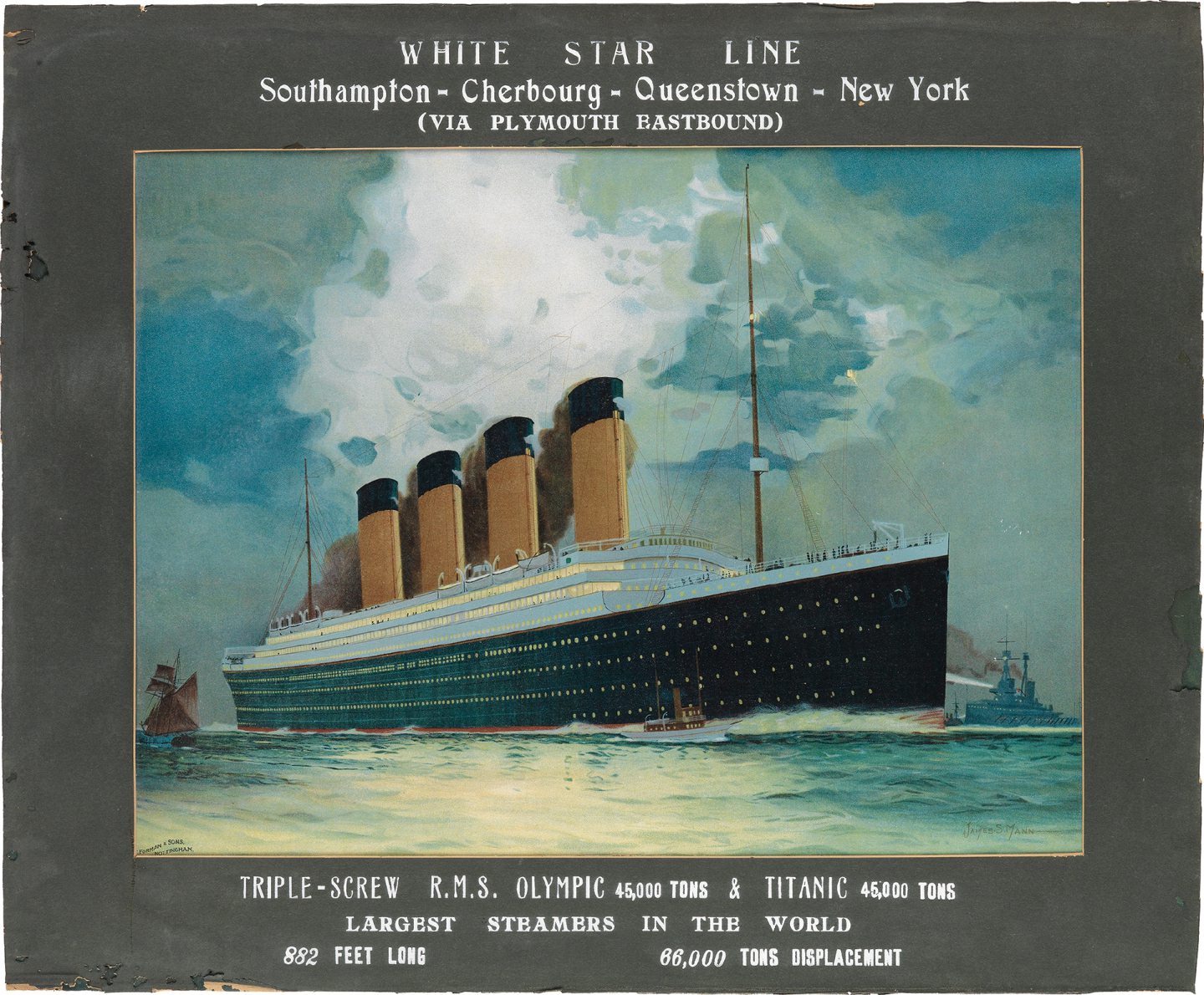
Dundee artist James Scrimgeour Mann was commissioned to produce the 1911 poster advertising transatlantic trips on Titanic and her sister ship Olympic.
Mann inherited his enthusiasm for the sea from his father who was captain of a Dundee ship and died at sea off the coast of South Africa in 1901.
Were binoculars key to the whole tragedy?
White Star Line merchant seaman David “Davy” Blair from Broughty Ferry was due to serve on the Titanic before a change in crewing lists at the last minute.
In his hurry to disembark the ship at Southampton, Davy accidently took with him the key for a locker in the crow’s nest that held the ship’s binoculars.
Spotting an iceberg in the dark waters of the Atlantic was virtually impossible, especially with a wind of 22 knots.
But at 21 minutes to midnight it loomed into plain view and lookout Fred Fleet rang the ship’s bell three times, signalling the warning to the bridge.
Orders were given to turn the ship but by doing this, the Titanic struck the iceberg a glancing blow, resulting in 12 square feet of the rivet heads being shorn off.
This opened the plates, allowing the sea to pour into the starboard side.
Fleet later told the official inquiry that having binoculars would have allowed for the iceberg to have been spotted sooner and saved the ship and the lives of the passengers.
When questioned how much sooner, Fleet replied: “Enough to get out of the way.”
Davy is known to history for his unwitting part in the sinking but was he made a scapegoat by Britain’s Board of Trade and Titanic’s officers?
Dundee Man Lost at Sea author Derek J Byrne said: “David Blair has long been labelled as the man who unwittingly helped to sink Titanic.
“However the truth does not support this impression.
“There were four or five pairs of binoculars on board Titanic during the voyage. Any of these could have been acquired by the lookouts if they really felt they needed them to increase their chances of seeing the ice.
“But the official findings of the British Inquiry held that glasses were ‘not necessary’.
“So, like The Courier headline, this is another Titanic myth that has been debunked.”
Another scapegoat with Dundee links
The SS Californian was the largest ship ever built in Dundee in 1901 and became another Titanic scapegoat after being blamed for not going to its rescue.
She was built by the Caledon shipyard and was going to Boston on the fateful night of April 14 1912 and was nearest to the Titanic when it hit the iceberg.
Stopped in ice, the crew on watch saw a ship’s mast lights and rockets exploding overhead and woke Captain Stanley Lord to tell him what was going on.
However, the Californian stayed where she was all night and we will never know if she might have saved lives if she had reacted to the distress signals.
It was left to another ship, the Carpathia, to come to the Titanic’s aid, manoeuvring around icebergs to get to the scene.
But by the time the Carpathia had arrived, the Titanic had sunk.
It was more than 24 hours after the collision before the grim reality of what happened was captured in print and caused panic around the world.
Always keen for a Dundee angle, the Evening Telegraph attempted to describe the scale of the ship by writing: “If the Titanic were placed on end, she would rise fully 400 feet above the Law”.
It is estimated that if the number of people who claimed to have sailed on Titanic and survived the sinking was calculated it would have filled the gigantic liner 10 times over.
Were there any Dundee passengers?
There was nobody from Dundee on the Titanic when it went down but two men might have been aboard the doomed vessel but for the vagaries of fate.
“Crawford James Sturrock should have sailed on the Titanic as the representative of an engineering firm but was delayed and missed the ship,” Derek added.
“Mr Sturrock lived in Kerrington Crescent in Broughty Ferry and died on April 17 1937, which was almost 25 years to the day after the tragedy happened.
“David Macintosh Wellard from Seagate decided to go to Winnipeg in 1912 and applied for a ticket on Titanic but was unsuccessful and sailed on another ship.
“Two other Dundonians who claimed to be near the site of the Titanic sinking were John Hendry and John Patrick Mannion who were firemen on the Monarch.
“The cargo ship sailed from New Orleans to Liverpool and the crew were unaware of the tragedy before docking on April 21 1912, as the vessel had no wireless telegraphy.”
The Courier interviewed the two men who claimed the Monarch “must have been quite close to the scene at the time – certainly not more than 20 miles off”.
The two crew members claimed “that at least 100 lives would have been saved” for they carried 10 lifeboats but does their account stand up to closer scrutiny?
Derek said: “They claimed to be within 20 miles of the Titanic and only saw one iceberg, which they did not regard as a big one despite the fact that the Californian was stopped for the night, north of Titanic, in an ice field and the Carpathia, that approached the site of Titanic’s sinking from the south, encountered a lot of ice.
“The other factor against their presence near the site of Titanic on the night of April 14 centres on calculating how long it would have taken them to travel to Liverpool from that position using their average cruising speed.
“If they had been near the sinking site they would have arrived at Liverpool two days before they actually did.”
Derek believes the state-of-the-art Goliath being felled by a state-of-the-nature David is why we are still so fascinated by the Titanic disaster after 110 years.
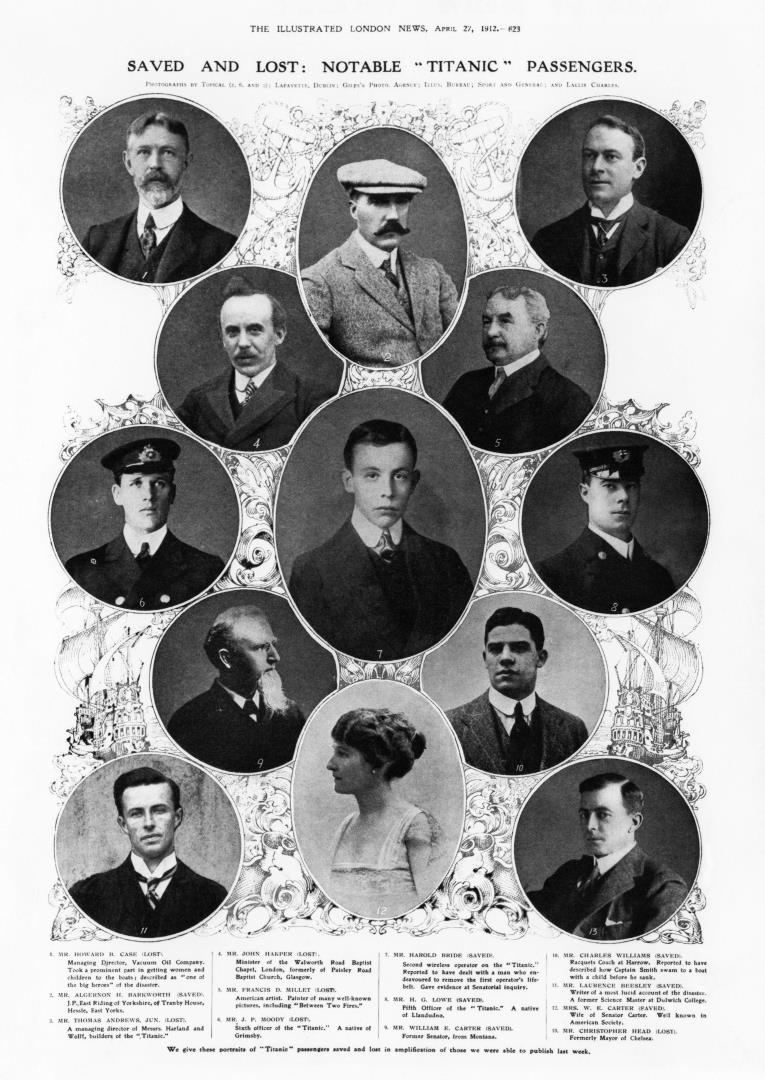
“It is 110 years since the tragedy but the drama incorporating its moral, social and human elements combine to make it a timeless story,” said Derek.
“The project by White Star Line to build the three most luxurious ships in the world boasted a pride and arrogance that seemed almost to defy God himself.
“Neither the White Star Line or Harland and Wolff ever stated that Titanic was unsinkable but the popular perception of its invulnerability was firmly entrenched.
“To see such a beautiful and majestic and yet strong and solid man-made creation disappear in under three hours was difficult for people to comprehend.
“It was a David and Goliath tale in spades and then some.”
More like this:
Photo mystery: Is this the face of the only Tayside victim of the Titanic?
SS Californian: Dundee-built ship forever associated with the Titanic sinking
